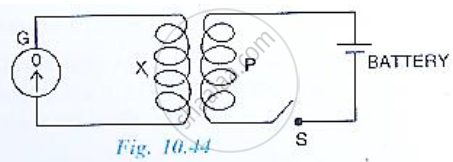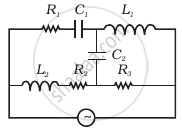Advertisements
Advertisements
Questions
Describe the construction and working of a transformer with a neat labelled diagram.
Explain the working of a transformer with a neat, labelled diagram.
Solution
Principle:
It is based on the principle of mutual induction, i.e., whenever the magnetic flux linked with a coil changes, an e.m.f is induced in the neighbouring coil.
- Construction:
a. A transformer consists of two sets of coils, primary P and secondary S, insulated from each other. Coil P is called the input coil, and coil S is called the output coil.
b. The two coils are wound separately on a laminated soft iron core.
- Working:
a. When an alternating voltage is applied to the primary coil, the current through the coil goes on changing. Hence, the magnetic flux through the core also changes.
b. As this changing magnetic flux is linked with both the coils, an e.m.f is induced in each coil.
c. The amount of the magnetic flux linked with the coil depends upon the number of turns of the coil.
d. Let, ‘Φ’ be the magnetic flux linked per turn with both the coils at a certain instant ‘t’.
e. Let ‘NP' and ‘NS’ be the number of turns of the primary and secondary coil,
NPΦ = magnetic flux linked with the primary coil at a certain instant ‘t’
NSΦ = magnetic flux linked with the secondary coil at a certain instant ‘t’
f. Induced e.m.f produced in the primary and secondary coil is given by,
`"e"_"p" = -("d"phi_"p")/"dt" = -"N"_"p"("d"phi)/"dt"` ….(1)
`"e"_"s" = -("d"phi_"s")/"dt" = -"N"_"s"("d"phi)/"dt"` ….(2)
g. Dividing equation (2) by (1),
∴ `"e"_"s"/"e"_"p" = "N"_"s"/"N"_"p"` ….(3)
Equation (3) represents equation of transformer.
The ratio `"N"_"s"/"N"_"p"` is called turns ratio (transformer ratio) of the transformer.
h. For an ideal transformer,
Input power = Output power
∴ ePIP = eSIS
∴ `"e"_"s"/"e"_"p" = "I"_"p"/"I"_"s"` ….(4)
i. From equation (3) and (4),
`"e"_"s"/"e"_"p" = "N"_"s"/"N"_"p" = "I"_"p"/"I"_"s"`
Notes
Students should refer to the answer according to their questions.
APPEARS IN
RELATED QUESTIONS
Derive an expression for e.m.f. and current in terms of turns ratio
A power transmission line feeds input power at 2200 V to a step-down transformer with its primary windings having 300 turns. Find the number of turns in the secondary to get the power output at 220 V.
Express the turn ratio in terms of voltages.
Which coil of a step up transformer is made thicker and why?
Name the transformer used in the power transmitting station of a power plant.
Name two factors on which the magnitude of an induced e.m.f. in the secondary coil depends.
Why is the core of a transformer laminated?
Name the phenomenon ?
Explain the significance of Lenz’s law to show the conservation of energy in electromagnetic induction.
The following diagram in Fig. 10.44 shows a coil X connected to a sensitive centre –zero galvanometer G and a coil P connected to a battery through a switch S.

(a) Describe the observation when the switch S is (i) closed suddenly, (ii) then kept closed, (iii) finally opened.
(b) Name and state the law which explains the above observations.
State the principle of working of a transformer. Can a transformer be used to step up or step down a d.c. voltage? Justify your answer.
Draw a labeled diagram of a full wave rectifier circuit. State its working principle. Show the input-output waveforms ?
Describe briefly, with the help of labelled diagram, working of a step-up transformer.
A step-up transformer converts a low voltage into high voltage. Does it not violate the principle of conservation of energy? Explain.
What is the ideal transformer?
What is the function of a step-up transformer?
Draw a labelled diagram to show the various parts of a step-up transformer and step down transformer.
(i) Draw a clear labelled diagram of an electric bell.
(ii) Explain in brief, its working.
(iii) What material is used for the core of an electric bell? State the reason.
Copy the given diagram of a transformer and complete it. Name the parts A and B. Name the part you have drawn to complete the diagram. What is the material of this part? Is this transformer a step-up or step-down? Give reason.
A transformer lowers e.m.f. from 220 V to 15 V. If 400 W power is given in primary, calculate (i) the current in primary coil and (ii) the current in secondary coil.
State the mathematical relation between a number of turns in the primary coil to a secondary coil in the step-up transformer.
Distinguish between Step up and Step Down Transformer.
A step-down transformer reduces the supply voltage from 220 V to 11 V and increase the current from 6 A to 100 A. Then its efficiency is
Explain the construction of transformer.
Give the advantage of AC in long distance power transmission with an illustration.
Find out the phase relationship between voltage and current in a pure inductive circuit.
A 200V/120V step-down transformer of 90% efficiency is connected to an induction stove of resistance 40 Ω. Find the current drawn by the primary of the transformer.
A transformer having efficiency of 80% is working on 200 V and 6 kW power supply. If the current in the secondary coil is 6 A, the voltage across the secondary coil and the current in the primary coil respectively are ____________.
Read the following paragraph and answer the question:

Long distance power transmissions
The large-scale transmission and distribution of electrical energy over long distances is done with the use of transformers. The voltage output of the generator is stepped up. It is then transmitted over long distances to an area sub-station near the consumers. There the voltage is stepped down. It is further stepped down at distributing sub-stations and utility poles before a power supply of 240 V reaches our homes.
We need to step-up the voltage for power transmission, so that ______.
Read the following paragraph and answer the question:

Long distance power transmissions
The large-scale transmission and distribution of electrical energy over long distances is done with the use of transformers. The voltage output of the generator is stepped up. It is then transmitted over long distances to an area sub-station near the consumers. There the voltage is stepped down. It is further stepped down at distributing sub-stations and utility poles before a power supply of 240 V reaches our homes.
A power transmission line feeds input power at 2300 V to a step down transformer with its primary windings having 4000 turns. The number of turns in the secondary in order to get output power at 230 V are ______.
Define a Transformer.
A transformer is used ______
Electrical energy is transmitted over large distances at high alternating voltages. Which of the following statements is (are) correct?
- For a given power level, there is a lower current.
- Lower current implies less power loss.
- Transmission lines can be made thinner.
- It is easy to reduce the voltage at the receiving end using step-down transformers.
For an LCR circuit, the power transferred from the driving source to the driven oscillator is P = I2Z cos φ.
- Here, the power factor cos φ ≥ 0, P ≥ 0.
- The driving force can give no energy to the oscillator (P = 0) in some cases.
- The driving force cannot syphon out (P < 0) the energy out of oscillator.
- The driving force can take away energy out of the oscillator.
Draw the effective equivalent circuit of the circuit shown in figure, at very high frequencies and find the effective impedance.

A transformer operating at primary voltage 8 kV and secondary voltage 160 V serves a load of 80 kW. Assuming the transformer to be ideal with purely resistive load and working on unity power factor, the loads in the primary and secondary circuit would be:
Two coils P and Q are kept near each other. When no current flows through coil P and current increase in coil Q at the rate 10A/s, the emf in coil P is 15mV. When coil Q carries no current and current of 1. 8A flows through coil P, the magnetic flux linked with the coil Q is ______.
Magnetic flux passing through a coil is initially 4 × 10-4 Wb. It reduces to 10% of its original value in t second. If the emf induced is 0. 72 mV then t in second is ______.
The large scale transmission of electrical energy over long distances is done with the use of transformers. The voltage output of the generator is stepped-up because of ______.
The primary coil of a transformer has 60 turns whereas its secondary coil has 3000 turns.
If a current of 5A flows in the primary coil, how much current will flow in a load in the secondary coil? State the assumption you have made regarding the transformer, in this calculation.
Derive the equation for a transformer.
What type of transformer is used in a mobile phone charger?
For what purpose are the transformers used?
